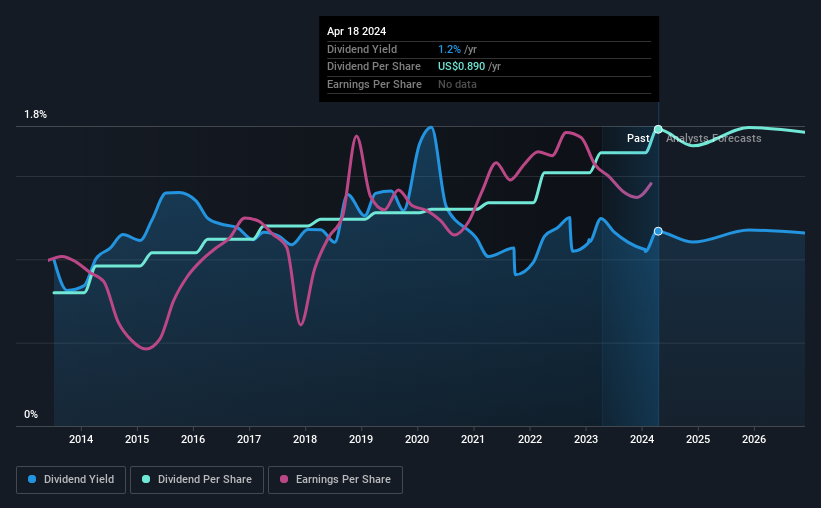Stock Analysis
- United States
- /
- Chemicals
- /
- NYSE:FUL
Is It Worth Considering H.B. Fuller Company (NYSE:FUL) For Its Upcoming Dividend?

Some investors rely on dividends for growing their wealth, and if you're one of those dividend sleuths, you might be intrigued to know that H.B. Fuller Company (NYSE:FUL) is about to go ex-dividend in just 4 days. Typically, the ex-dividend date is one business day before the record date which is the date on which a company determines the shareholders eligible to receive a dividend. The ex-dividend date is an important date to be aware of as any purchase of the stock made on or after this date might mean a late settlement that doesn't show on the record date. Therefore, if you purchase H.B. Fuller's shares on or after the 24th of April, you won't be eligible to receive the dividend, when it is paid on the 9th of May.
The company's upcoming dividend is US$0.2225 a share, following on from the last 12 months, when the company distributed a total of US$0.82 per share to shareholders. Looking at the last 12 months of distributions, H.B. Fuller has a trailing yield of approximately 1.2% on its current stock price of US$76.15. We love seeing companies pay a dividend, but it's also important to be sure that laying the golden eggs isn't going to kill our golden goose! We need to see whether the dividend is covered by earnings and if it's growing.
See our latest analysis for H.B. Fuller
Dividends are typically paid out of company income, so if a company pays out more than it earned, its dividend is usually at a higher risk of being cut. That's why it's good to see H.B. Fuller paying out a modest 29% of its earnings. Yet cash flows are even more important than profits for assessing a dividend, so we need to see if the company generated enough cash to pay its distribution. It paid out 15% of its free cash flow as dividends last year, which is conservatively low.
It's positive to see that H.B. Fuller's dividend is covered by both profits and cash flow, since this is generally a sign that the dividend is sustainable, and a lower payout ratio usually suggests a greater margin of safety before the dividend gets cut.
Click here to see the company's payout ratio, plus analyst estimates of its future dividends.

Have Earnings And Dividends Been Growing?
Businesses with shrinking earnings are tricky from a dividend perspective. If earnings decline and the company is forced to cut its dividend, investors could watch the value of their investment go up in smoke. So we're not too excited that H.B. Fuller's earnings are down 3.5% a year over the past five years.
Another key way to measure a company's dividend prospects is by measuring its historical rate of dividend growth. H.B. Fuller has delivered 8.3% dividend growth per year on average over the past 10 years.
The Bottom Line
Is H.B. Fuller an attractive dividend stock, or better left on the shelf? Earnings per share are down meaningfully, although at least the company is paying out a low and conservative percentage of both its earnings and cash flow. It's definitely not great to see earnings falling, but at least there may be some buffer before the dividend needs to be cut. Overall we're not hugely bearish on the stock, but there are likely better dividend investments out there.
So while H.B. Fuller looks good from a dividend perspective, it's always worthwhile being up to date with the risks involved in this stock. Be aware that H.B. Fuller is showing 2 warning signs in our investment analysis, and 1 of those doesn't sit too well with us...
If you're in the market for strong dividend payers, we recommend checking our selection of top dividend stocks.
Valuation is complex, but we're helping make it simple.
Find out whether H.B. Fuller is potentially over or undervalued by checking out our comprehensive analysis, which includes fair value estimates, risks and warnings, dividends, insider transactions and financial health.
View the Free AnalysisHave feedback on this article? Concerned about the content? Get in touch with us directly. Alternatively, email editorial-team (at) simplywallst.com.
This article by Simply Wall St is general in nature. We provide commentary based on historical data and analyst forecasts only using an unbiased methodology and our articles are not intended to be financial advice. It does not constitute a recommendation to buy or sell any stock, and does not take account of your objectives, or your financial situation. We aim to bring you long-term focused analysis driven by fundamental data. Note that our analysis may not factor in the latest price-sensitive company announcements or qualitative material. Simply Wall St has no position in any stocks mentioned.
About NYSE:FUL
H.B. Fuller
H.B. Fuller Company, together with its subsidiaries, formulates, manufactures, and markets adhesives, sealants, coatings, polymers, tapes, encapsulants, additives, and other specialty chemical products.
Average dividend payer with moderate growth potential.

